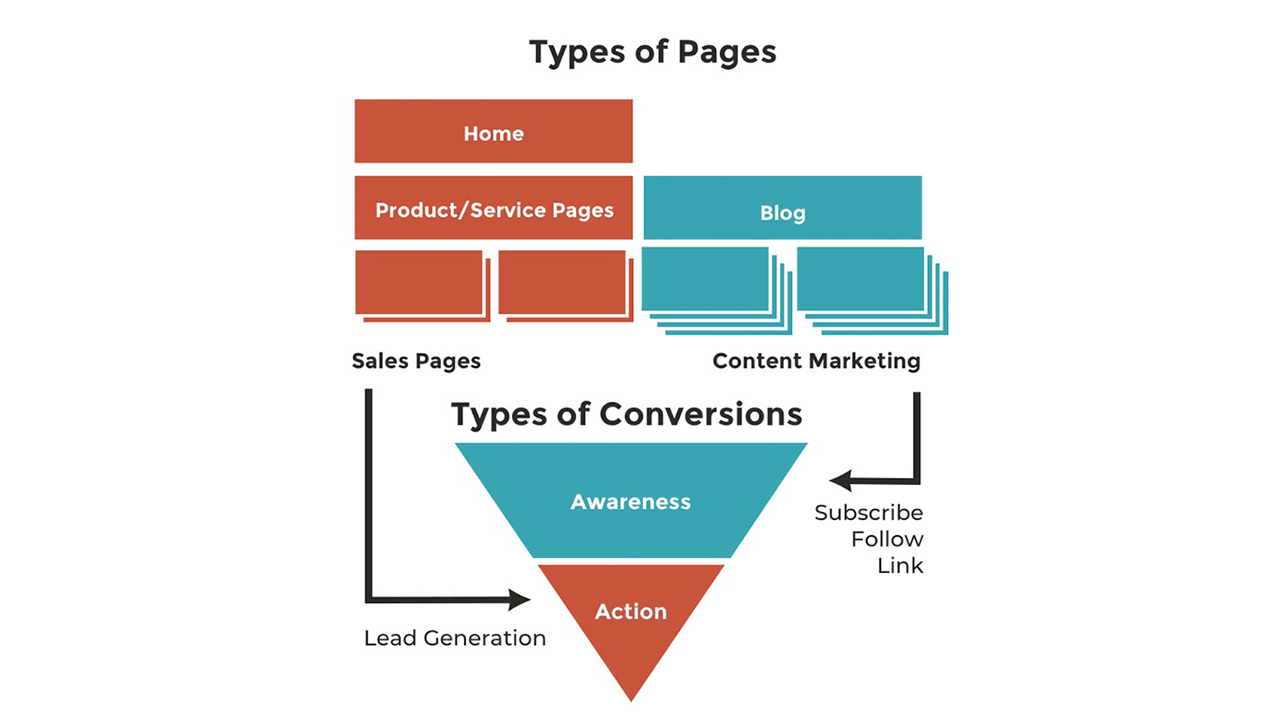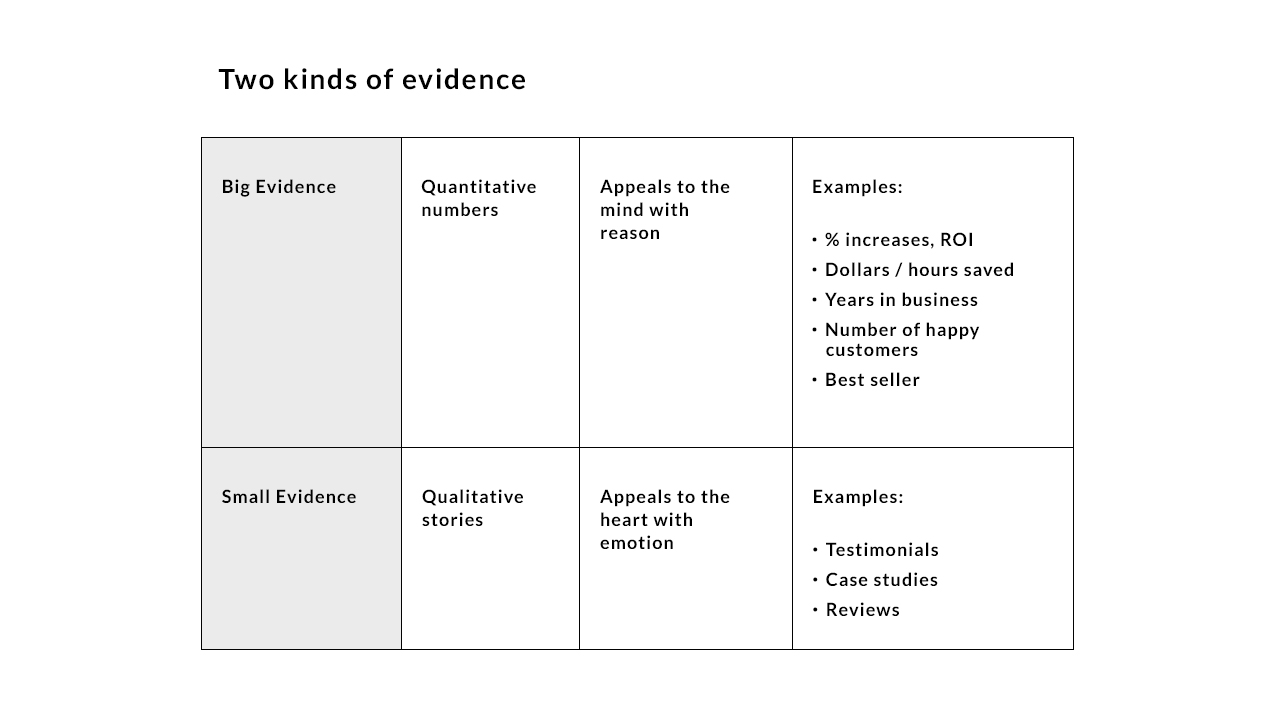Even with the many website tracking tools and data collection methods available to marketers, the average website conversion rate stands at only 2.35%. This is a concerning figure, especially since conversions — be it online leads, inbound calls, subscribers, eCommerce customers, event sign-ups, or donations — are the main goal of any website. Missed conversions mean lost revenue.
So, what can you do to raise your website conversion rates? In a recent webinar with Andy Crestodina, CMO of Orbit Media Studios, entitled Your 60-Minute Masterclass: Website Conversion Optimization, we presented the following list of best practices.
1. Separate Your Website into Sales Pages and Content Marketing Pages
When building your site, you’ll want to target two main types of visitors: informational and transactional.
Informational visitors (who are the majority) are just searching for answers to their questions — they aren’t planning to buy anything. To attract these visitors, you should create broad, top-of-the-funnel content that meets their curiosity and raises awareness of your product or service. One effective way to do this is with a “blog” or “resources library” page on your website. Since these visitors are high up in the funnel, you should provide low-commitment call-to-actions like “subscribe.”
Transactional visitors are coming to your website with purchasing intent. To capture conversions from these users, you’ll need to answer their pre-purchase questions, provide evidence about the value your product or service, and offer a compelling call-to-action. This is best accomplished on product or service pages.
These tips focus on appealing to transactional website visitors — the revenue-drivers.
2. Anticipate Your Audience’s Questions
If you don’t truly understand your audience — their needs, anxieties, hopes, and challenges — it’s incredibly difficult to sell to them. When building a website, you need to anticipate your audience’s questions so you can reassure them and alleviate friction in the conversion process. If you’re unable to quickly and seamlessly field their questions, they’ll likely leave and turn to a competitor who can.
To learn what questions your audience is asking, you can analyze website tracking data, invite them to participate in a survey, or conduct interviews. Another option, which brands often overlook, is to go to directly to the voice of the customer. With call tracking and analytics, you can see which website pages are driving phone calls to your business and review conversation transcripts to identify common questions callers need answered before they decide on a purchase. You can then add those questions and answers to the page they called from to improve SEO traffic and website conversion rates.
3. Present Your Content Intuitively
According to Andy Crestodina, 60% of websites fail to convert customers due to “findability.” Anticipating questions is one thing, but if you bury the answers on various subpages, users may never see them.
FAQs pages are a common misstep in website design. Users — especially mobile users — want to view your content with as little friction as possible. Rather than forcing them to navigate to a separate page to answer their burning questions, you should present the answers on your product or services pages in a logical flow. This will lower your bounce rates and ensure a smoother experience.
4. Support Your Product or Service with Evidence
You can write all the copy you want about the value of your product or service, but all you’re doing is feeding your audience unsubstantiated marketing claims. To truly earn their trust and sway their opinion, you need to provide either Big Evidence or Small Evidence (preferably a mixture of the two).
Many brands neglect to include small evidence — however it’s more important than people realize. As we know from basic psychology, many human decisions are based on emotion rather than fact. This makes small evidence a powerful tool. Just think about Amazon — almost half of each product page is made up of small evidence, in the form of user reviews.
5. Use This Testimonial Format
The below example is an ideal testimonial format. These 7 elements catch the reader’s eye, allow them to easily skim the content, and provide credibility.
Instead of creating a single “testimonials” page, distribute your testimonials across their relevant product pages to increase visibility.
6. Create Long Website Pages
Long website pages are proven to convert better than short pages. Think about it this way: you don’t want to prematurely stop a conversation with a potential customer. All visitors require a different amount of proof to ultimately convert, so you should provide enough evidence to sway even your most skeptical visitors. If your heat maps reveal a 75% drop-off halfway through your pages, that’s okay — if you cut this page short, you create a 100% drop-off, preventing many visitors from continuing their interactions and getting the information they need. However, don’t overcrowd your pages — ensure there’s one main focus at every scroll depth.
7. Use Powerful Call-to-Actions
According to Andy Crestodina, using first-person language on call-to-action (CTA) buttons increases conversion rates by 90%. For instance, rather than “Start Your Free Trial,” use “Start My Free Trial” on your CTA buttons. This allows the user to more easily envision themself performing the action.
In addition to using first-person language, you should also ensure your CTA buttons are specific, vivid, and answer visitors’ questions. For example, for a blog, “Subscribe” is far less effective than “Join over 5,000 readers who receive weekly marketing tips.” This language is more vivid — it shows the visitor more evidence and it describes exactly what they’d be committing to.
8. Make It Easy for Customers to Call You
When optimizing your site, it’s important to take call conversions into account as well. Make sure it’s easy for customers to find your phone number and call you — especially on mobile devices. Include a click-to-call phone number in the header and footer of each website page, so users can seamlessly engage with one of your agents to ask questions or make a purchase.
9. Track and Analyze Call Conversions
While marketers can quantify the exact number of online conversions they receive, phone calls are often a black hole. This is problematic since inbound calls are often the most valuable conversions — they convert to 10x-15x more revenue than form fills. To truly optimize your website, you need to understand the total number of conversions you’re driving — both online and over the phone — and the value of those conversions to your business. Without this full data set, you could be making uninformed decisions and missing out on revenue.
10. Test and Optimize
Website optimization is an ongoing process. Through continual A/B testing and refinement, you can gradually increase your website conversions. Heat maps, website tracking tools, and call tracking solutions are all valuable tools to help you take an informed, data-driven approach.
Check out our webinar Your 60-Minute Masterclass: Website Conversion Optimization to learn more best practices from Andy Crestodina and the DialogTech team.
Read More: More Ways to Boost Website Conversion


